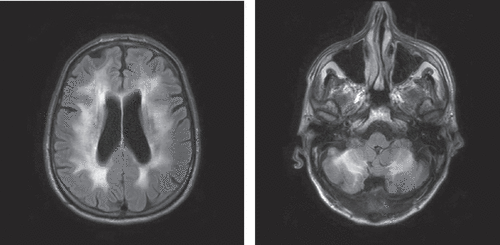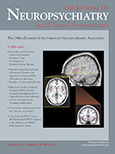Pathological Crying Associated With Fragile X-Associated Tremor/Ataxia Syndrome
To the Editor: The authors describe a 66-year-old man with a history of fragile X–associated tremor/ataxia syndrome who presented with pathological crying in the absence of a depressive disorder. Brain imaging showed widespread white matter hyperintensities in subcortical regions and cerebellar peduncles. To our knowledge, this is the first description of pathological crying and associated brain pathology in fragile X–associated tremor/ataxia syndrome.
Case report
A 66-year-old man with a recent diagnosis of fragile X–associated tremor/ataxia syndrome was referred to our neuropsychiatric outpatient clinic because of dysphoric mood, loss of interest, lack of motivation, and diminished appetite. During a psychiatric interview, the patient’s attitude shifted from slightly disinhibited to apathetic. Most strikingly, there was important emotional lability, characterized by frequent and brief (less than 1 minute) crying, with sudden onset and termination. These episodes of pathological crying were involuntary and inappropriate. Pathological crying could occur at any time, but the frequency increased as the content of the conversation became more emotional. These episodes of pathological crying were present for 2 years. Treatment with citalopram did not have any effect on the pathological crying or symptoms related to motivation. Recently, escitalopram was started with some beneficial effects on the frequency of pathological crying, but it was discontinued because of decreased libido and emotional blunting. A mental examination showed prominent apathy and pathological crying, but no signs of depression that were unrelated to motivation. Neuropsychological testing revealed poor sustained attention, executive dysfunction, and impaired memory encoding. MRI data showed prominent periventricular leucomalacia, limited cortico-subcortical atrophy, and middle cerebellar atrophy with T2 white matter hyperintensities (Figure 1). Based upon this information, we withheld an amotivational syndrome, cognitive impairment and pathological crying most probably due to widespread subcortical and cerebellar white matter hyperintensities associated with fragile X–associated tremor/ataxia syndrome.

FIGURE 1. MRI Data of a Reported Case of Fragile X–Associated Tremor/Ataxia Syndrome
Fluid-attenuated inversion recovery sequence showing periventricular white matter lesions (left) and cerebellar white matter lesions (right).
Discussion
Pathological crying is defined as uncontrollable, brief, intense episodes of crying, which may be incongruent to the emotional state and appear with or without emotion-inducing stimulus. Pathological crying can be caused by many neurological disorders, with variable prevalence.1
The exact pathogenesis of pathological crying remains unclear. According to recent theoretical models, regulation of emotional expression is critically dependent on the integrity of the connections between the cerebral cortex and cerebellum. Consequently, lesions located along the cerebro-ponto-cerebellar pathway may lead to distorted regulatory mechanisms or information transfer to the cerebellum, causing inappropriate emotional expression.2
Although this is the first description of pathological crying in fragile X–associated tremor/ataxia syndrome, it must be noted that other neuropsychiatric symptoms are common in fragile X–associated tremor/ataxia syndrome, including obsessive-compulsive and psychotic symptoms, interpersonal sensitivity, depressive symptoms and symptoms of anxiety, and somatization.3 Our case showed the typical signs of frontal network dysfunction associated with fragile X–associated tremor/ataxia syndrome, including a dysexecutive syndrome, apathy, and agitation.3
Taken together, our case report suggests that, in patients with fragile X–associated tremor/ataxia syndrome and widespread subcortical and cerebellar white matter damage, pathological crying may occur without comorbid depression and is likely to be related to the neural changes.
1 : Pathological laughing and crying : epidemiology, pathophysiology and treatment. CNS Drugs 2008; 22:531–545Crossref, Medline, Google Scholar
2 : Neuroanatomy of pathological laughing and crying: a report of the American Neuropsychiatric Association Committee on Research. J Neuropsychiatry Clin Neurosci 2009; 21:75–87Link, Google Scholar
3 : A review of fragile X premutation disorders: expanding the psychiatric perspective. J Clin Psychiatry 2009; 70:852–862Crossref, Medline, Google Scholar



